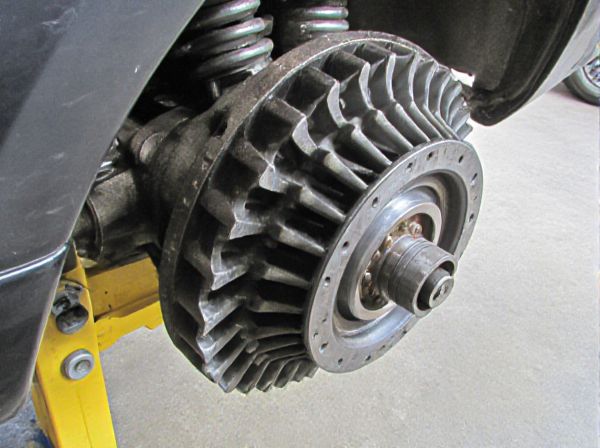
Photo illustration: Torsen vs Spool
Torsen differentials provide smooth torque distribution between wheels, enhancing traction and stability on various terrains without sudden engagement. Spool differentials, in contrast, lock both wheels solidly together for maximum power delivery, ideal for drag racing but reducing maneuverability in tight turns. Your choice depends on whether you prioritize on-road handling or off-road performance.
Table of Comparison
| Feature | Torsen Differential | Spool Differential |
|---|---|---|
| Type | Torque-Sensing Limited Slip | Solid Lock |
| Function | Distributes torque based on traction | Locks both wheels to spin at the same speed |
| Traction Performance | Improved on slippery surfaces | Maximum traction, no slip |
| Handling | Better cornering, less tire wear | Poor cornering, increased tire wear |
| Noise | Quiet operation | Loud, clunking noise |
| Durability | High, suitable for daily driving | Very high, ideal for racing and off-road |
| Cost | Higher price | Lower price |
| Application | Street, sport, off-road vehicles | Race cars, off-road rock crawling |
Introduction to Differential Types
Torsen and spool differentials represent two distinct types of drivetrain components used to distribute torque between wheels. Torsen differentials utilize a torque-sensing mechanism with worm gears allowing for variable torque distribution under different traction conditions, enhancing vehicle stability and handling. In contrast, spool differentials mechanically lock both wheels together, forcing them to rotate at the same speed, which improves traction but can cause handling difficulties during turns.
What is a Torsen Differential?
A Torsen differential is a type of limited-slip differential that uses helical gears to distribute torque between wheels, enhancing traction by automatically biasing power to the wheel with more grip. Unlike a spool, which rigidly connects both wheels on an axle causing them to rotate at the same speed, a Torsen differential allows for smooth cornering by permitting different wheel speeds while preventing excessive wheel spin. This advanced torque-sensing mechanism is commonly used in performance and off-road vehicles to improve handling and stability.
What is a Spool Differential?
A spool differential is a fixed connection between the two wheels on an axle, forcing them to rotate at the same speed regardless of traction conditions. Unlike Torsen differentials, which allow for torque distribution based on wheel slip, a spool provides no differentiation, maximizing power transfer to both wheels. This makes spools ideal for drag racing or off-road applications where wheel slip must be minimized.
Key Differences: Torsen vs Spool
Torsen differentials use a set of helical gears to provide torque biasing between wheels, allowing for smoother power transfer and improved traction on uneven surfaces compared to spool differentials. A spool differential locks both wheels together, forcing them to rotate at the same speed, which offers maximum traction on straight-line acceleration but compromises cornering ability and increases tire wear. Torsen differentials balance performance and drivability with limited slip capability, while spool differentials prioritize full locking effect at the expense of maneuverability.
Performance Comparison: Torsen vs Spool
Torsen differentials offer superior traction and handling by dynamically distributing torque between wheels based on grip levels, making them ideal for performance driving on varied surfaces. Spool differentials lock both wheels on an axle together, providing maximum power delivery but compromising cornering ability and increasing tire wear. In high-performance scenarios, a Torsen differential enhances stability and control, whereas a spool delivers raw power with less finesse.
Handling and Traction Analysis
Torsen differentials enhance handling by distributing torque variably between wheels, improving cornering stability and traction on uneven surfaces. Spool differentials provide a fixed connection, delivering maximum traction by forcing both wheels to rotate at the same speed, which can reduce maneuverability during turns. In high-performance and off-road scenarios, Torsen units offer a balance of grip and control, while spool setups prioritize straight-line traction at the expense of smooth handling.
Pros and Cons of Torsen Differentials
Torsen differentials provide superior torque distribution to the wheels, enhancing traction and handling by automatically adjusting power based on grip levels without electronics. They offer smooth, quiet operation and improved cornering stability compared to spool differentials, which lock both wheels together for constant torque but reduce maneuverability and increase tire wear. However, Torsen differentials are more complex and expensive, and they may struggle with very low traction situations where one wheel loses all grip, unlike spools that ensure equal power delivery regardless of conditions.
Pros and Cons of Spool Differentials
Spool differentials provide maximum traction by rigidly locking both axles together, making them ideal for off-road and drag racing where wheel slip is undesirable. Their simplicity, durability, and low cost are major advantages, but they cause significant tire wear and difficulty in turning on pavement due to the lack of differential action. This can lead to increased drivetrain stress and reduced handling performance compared to limited-slip options like Torsen differentials.
Best Applications for Torsen and Spool
Torsen differentials excel in high-performance street and off-road vehicles requiring smooth torque distribution and improved handling during cornering by automatically adjusting torque between wheels. Spool differentials are best suited for drag racing and rock crawling applications where maximum wheel lockup and consistent torque delivery to both wheels are critical for traction and acceleration. Choosing Torsen is ideal for balanced driving conditions with frequent turns, while spool differentials provide unbeatable traction in straight-line power and extreme off-road scenarios.
Choosing the Right Differential for Your Needs
Choosing between a Torsen and a spool differential depends on driving conditions and performance goals. A Torsen differential provides smooth torque distribution and improved traction on varied surfaces, ideal for street and track use. In contrast, a spool locks both wheels together for maximum power transfer but sacrifices cornering flexibility, making it suitable primarily for drag racing or dedicated track applications.
 caratoz.com
caratoz.com